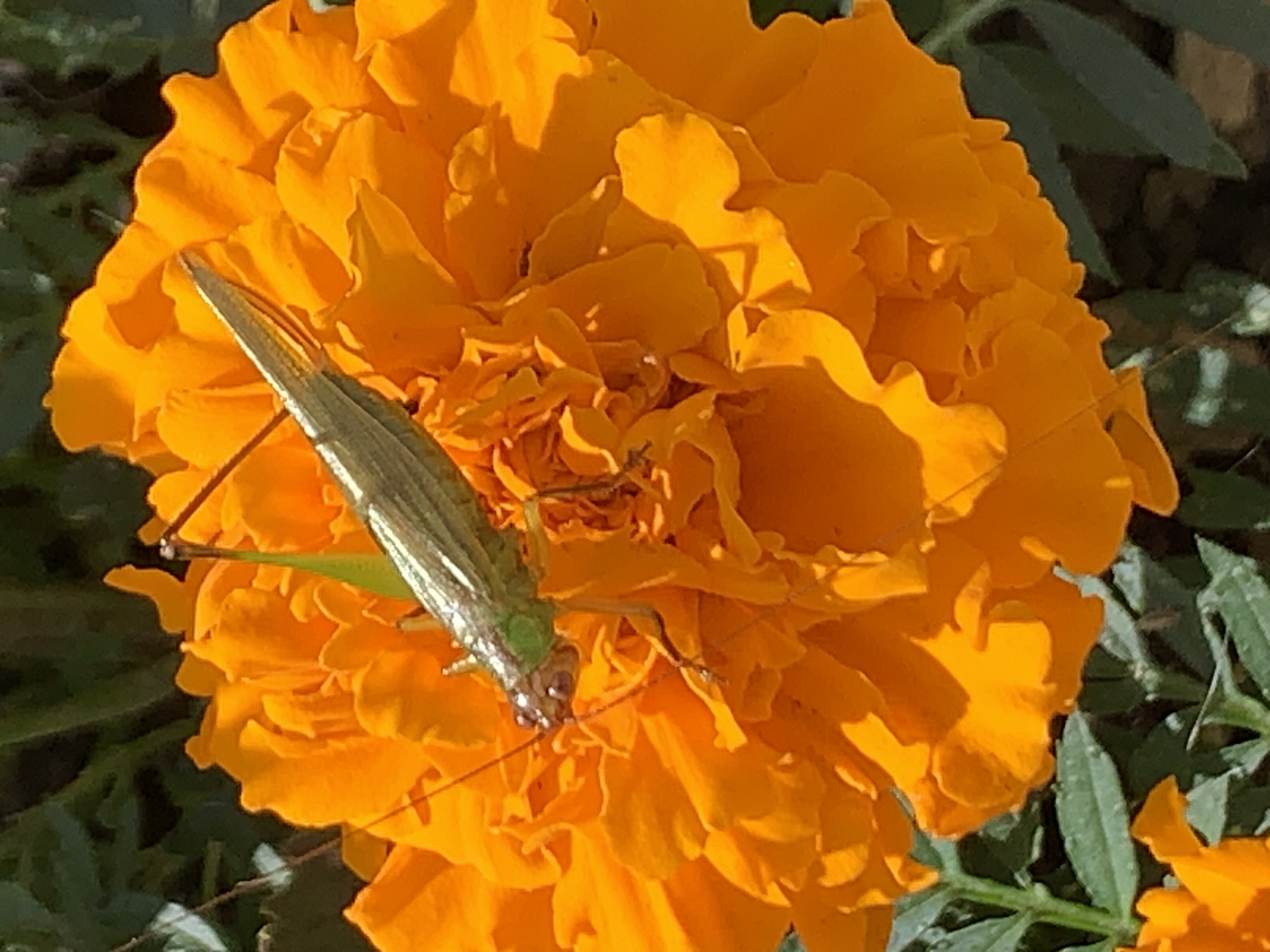Outside my study window, along with the crickets that have been singing there all summer, there’s another voice. The singer starts with a short series of ticks and then melts into a long rasping rattle. For hours he repeats his song, sitting in the same place along the edge of the sidewalk. He is quiet in the early mornings, waiting for the sun to warm him enough to sing. On hot evenings, he will continue long into the night.
He is a common meadow katydid (Orchelimum vulgare). His song doesn’t make me think of his name though. Another type of katydid sings “Katy did Katy didn’t” in the trees. I never hear those katydids on Owl Acres. The meadow katydids though are well represented.
Our little singer is about an inch long. He has a green body and red eyes. He might also be called a long-horned grasshopper because his antennae are as long as his whole body. He has brown legs and wings and a brown stripe over his head and shoulders. He looks a bit like a leaf, and his coloring helps him blend into the grass very easily to escape predators. Snakes, mice, birds, spiders, frogs and lizards find him a tasty treat.
He creates his song by using specialized structures on his leathery forewings. At the base of his right forewing is a scraper that engages with a file, or row of bumps, on his left forewing. So as he alternately raises and lowers the wings, they rub against each other making the rattling buzz. This kind of singing is called stridulation and is common to crickets, grasshoppers and meadow katydids. It’s amazing to think how fast he’d have to move his wings to get that characteristic buzz.
He’s singing for two reasons. One is to attract a mate, and the other is to defend his territory from other male meadow katydids. If his loud song doesn’t scare off a pretender, he’s not above “hand to hand” grappling to explain it to him. Defeated, the intruder leaves quietly while the victor shouts in triumph from his perch in the grass.
The female doesn’t sing. Instead, she listens carefully to the quality of a male’s song and uses her own criteria to judge whether he would be the right mate. She only mates once, so this is very important. Her ears, and his too for that matter, are located on the lower part of the forelegs. They look like little oval-shaped holes.
Once she’s found the right singer, she mates and, in September or October, she finds the right spot to lay her eggs. She will insert the eggs one at a time into the stems or twigs of suitable plants. To do that, she grabs the stem with four of her six legs and pushes the long, curved ovipositor at the end of her abdomen into the stem. She lays the egg, and then withdraws the ovipositor. She covers up the hole by chewing the stem at the insertion point to splinter the fiber. Then she reinserts her ovipositor into the hole but angled back the other direction and lays another egg. She may do this several times before finding a new stem. Sorghum and raspberry canes make good candidates for her eggs.
The eggs will rest undisturbed over the winter inside the twigs or the plant stems. In May or June when the weather warms up, the eggs will hatch, and the nymphs will emerge. They look like tiny wingless versions of the adults and start eating plant material. They will molt several times until, in late July or august, they will molt for the last time and emerge as winged adults. As adults, they will eat smaller insects like aphids. They need protein for their eggs. And the cycle begins again.
I love those cool, crisp October days when the insects are at full volume singing their version of “It’s now or never.” There are far more singers out there than I have been able to identify. I’ll keep listening until the frost puts an end to it all.
Photo by Author. Alt text: Sleek green grasshopper-like insect sits on a bright orange-yellow marigold bloom outside the front door of the house. Evidence of an earlier escape from a predator can be seen, as this katydid has lost one of its jumping legs. This is actually a “posed” photo, we‘re not sure the shy katydid would be caught dead in this flamboyant setting. The katydid had been in the house and was captured and removed to the flower where its picture was taken. It didn’t stick around to read the reviews.

2 comments
Lovely piece!!! And great picture!